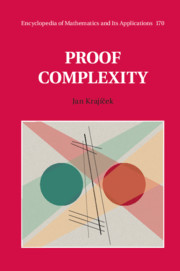Refine search
Actions for selected content:
48287 results in Computer Science
9 - The Two Worlds of Bounded Arithmetic
- from Part II - Upper Bounds
-
- Book:
- Proof Complexity
- Published online:
- 25 March 2019
- Print publication:
- 28 March 2019, pp 185-196
-
- Chapter
- Export citation
20 - Model Theory and Lower Bounds
- from Part IV - Beyond Bounds
-
- Book:
- Proof Complexity
- Published online:
- 25 March 2019
- Print publication:
- 28 March 2019, pp 442-455
-
- Chapter
- Export citation
Contents
-
- Book:
- Analyzing Network Data in Biology and Medicine
- Published online:
- 18 March 2019
- Print publication:
- 28 March 2019, pp vii-viii
-
- Chapter
- Export citation
Frontmatter
-
- Book:
- Proof Complexity
- Published online:
- 25 March 2019
- Print publication:
- 28 March 2019, pp i-iv
-
- Chapter
- Export citation
21 - Optimality
- from Part IV - Beyond Bounds
-
- Book:
- Proof Complexity
- Published online:
- 25 March 2019
- Print publication:
- 28 March 2019, pp 456-471
-
- Chapter
- Export citation
Frontmatter
-
- Book:
- Artificial Intelligence and Conservation
- Published online:
- 18 March 2019
- Print publication:
- 28 March 2019, pp i-iv
-
- Chapter
- Export citation
Part III - Lower Bounds
-
- Book:
- Proof Complexity
- Published online:
- 25 March 2019
- Print publication:
- 28 March 2019, pp 261-262
-
- Chapter
- Export citation
16 - Algebraic and Geometric Proof Systems
- from Part III - Lower Bounds
-
- Book:
- Proof Complexity
- Published online:
- 25 March 2019
- Print publication:
- 28 March 2019, pp 337-352
-
- Chapter
- Export citation
Part I - Basic Concepts
-
- Book:
- Proof Complexity
- Published online:
- 25 March 2019
- Print publication:
- 28 March 2019, pp 9-10
-
- Chapter
- Export citation
Acknowledgements
-
- Book:
- Proof Complexity
- Published online:
- 25 March 2019
- Print publication:
- 28 March 2019, pp xv-xvi
-
- Chapter
- Export citation
11 - Examples of Upper Bounds and p-Simulations
- from Part II - Upper Bounds
-
- Book:
- Proof Complexity
- Published online:
- 25 March 2019
- Print publication:
- 28 March 2019, pp 211-232
-
- Chapter
- Export citation
Contents
-
- Book:
- Proof Complexity
- Published online:
- 25 March 2019
- Print publication:
- 28 March 2019, pp vii-xii
-
- Chapter
- Export citation
1 - Introduction
-
- Book:
- Artificial Intelligence and Conservation
- Published online:
- 18 March 2019
- Print publication:
- 28 March 2019, pp 1-14
-
- Chapter
- Export citation
Part II - Upper Bounds
-
- Book:
- Proof Complexity
- Published online:
- 25 March 2019
- Print publication:
- 28 March 2019, pp 163-164
-
- Chapter
- Export citation
Estimating word-level quality of statistical machine translation output using monolingual information alone
-
- Journal:
- Natural Language Engineering / Volume 26 / Issue 1 / January 2020
- Published online by Cambridge University Press:
- 27 March 2019, pp. 73-94
-
- Article
- Export citation
A TIME-DEPENDENT PÓLYA URN WITH MULTIPLE DRAWINGS
-
- Journal:
- Probability in the Engineering and Informational Sciences / Volume 34 / Issue 4 / October 2020
- Published online by Cambridge University Press:
- 27 March 2019, pp. 469-483
-
- Article
- Export citation
A general proof certification framework for modal logic
-
- Journal:
- Mathematical Structures in Computer Science / Volume 29 / Issue 8 / September 2019
- Published online by Cambridge University Press:
- 26 March 2019, pp. 1344-1378
-
- Article
- Export citation

Proof Complexity
-
- Published online:
- 25 March 2019
- Print publication:
- 28 March 2019
Universal properties for universal types in bifibrational parametricity
-
- Journal:
- Mathematical Structures in Computer Science / Volume 29 / Issue 6 / June 2019
- Published online by Cambridge University Press:
- 22 March 2019, pp. 810-827
-
- Article
- Export citation
STANDARD BAYES LOGIC IS NOT FINITELY AXIOMATIZABLE
-
- Journal:
- The Review of Symbolic Logic / Volume 13 / Issue 2 / June 2020
- Published online by Cambridge University Press:
- 22 March 2019, pp. 326-337
- Print publication:
- June 2020
-
- Article
- Export citation
